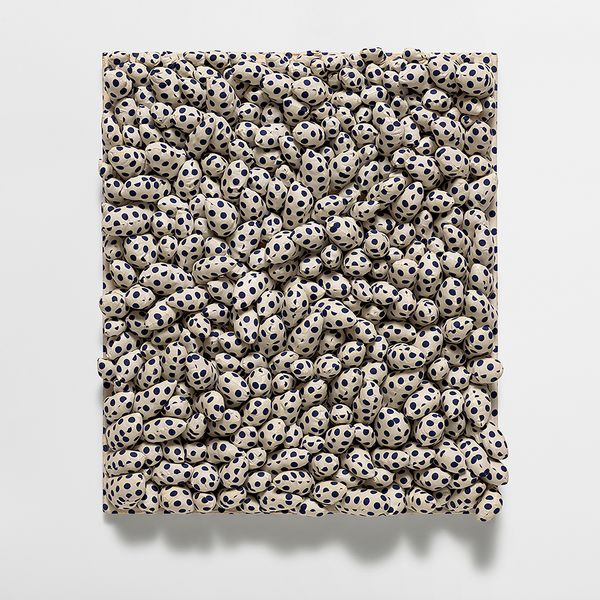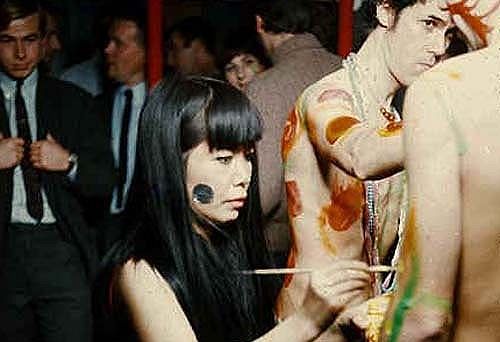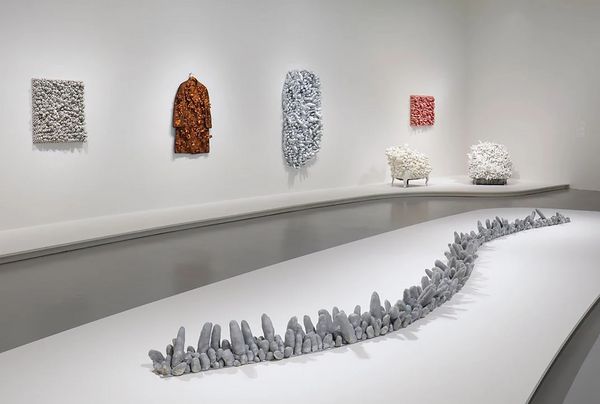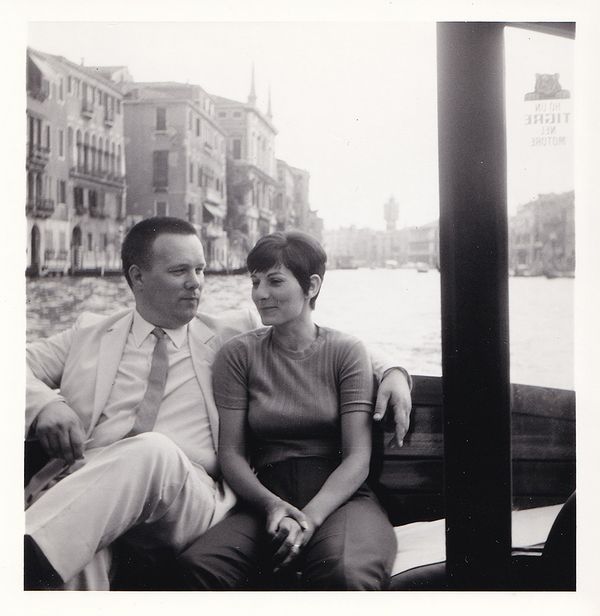Agnes and Frits Becht in Venice for the Biennale, 1966.
Dutch collectors Agnes and Frits Becht were active in the European contemporary art scene from the 1960s to the 1990s. The couple treasured their personal relationships with the artists they collected, including Lucio Fontana, Jan Dibbets, and Yayoi Kusama.
Their granddaughter, Eline Becht, wrote in the curatorial note to accompany the exhibition, Personal Reflection: Works and Stories from the Agnes and Frits Becht Collection, The Hague, 2022, that the two collectors had “a special approach to collecting, close to patronage, where the collector wishes to financially support the artist while giving them creative freedom and trusting their process.”
This was especially true of their relationship with Kusama. The Bechts’ financial support opened new professional opportunities for the artist in Europe, beginning with their purchase of Red Stripes and Blue Spots in 1965. The two works have remained in the family collection ever since and have featured in five major Kusama retrospectives, among other exhibitions. As some of Kusama’s earliest soft sculptures, Red Stripes and Blue Spots are immediately recognizable as iconic early works by an international superstar.

Yayoi Kusama, Red Stripes, 1965. 20th Century & Contemporary Art Evening Sale New York.
“Their collection tells the story of what they loved, the adventures they lived, the people they met, and the relationships they built along the way.”
—Eline Becht, 2022

Yayoi Kusama, Blue Spots, 1965. 20th Century & Contemporary Art Evening Sale New York.
This acquisition was the beginning of the couple’s relationship with the artist: as a result of the Bechts’ patronage, Internationale Galerij Orez offered Kusama a contract for exclusive representation in Europe. Two years later, the Bechts purchased an entire shipping container of thirty-nine works by Kusama, sight unseen.
Below, Jean-Paul Engelen — President, Americas and Worldwide Co-Head of 20th Century & Contemporary Art at Phillips — sits down with Agnes Becht and her son Brendan — chef and proprietor of Zazà Ramen in Milan, which showcases contemporary art in its dining room — to hear the stories of the family’s life lived with art.
Red Stripes and Blue Spots are on offer in Phillips’ 20th Century & Contemporary Art Evening Sale New York, 17 May 2023.
Jean-Paul Engelen: Agnes, you and Frits were friends with many artists in the ‘60s. Do you have any favorite memories that you can share of that particular period?
Agnes Becht: There are so many! (laughs). We also would go to London and Paris for exhibitions and to visit [Tetsumi] Kudo and [Kurihara] Hiroko, so there are a lot of memories. We would see many exhibitions and would travel with Brendan when he was small. But I do not have too many memories about Kusama, only when we saw her at the Birds Club — that is a memory that I must share.
JPE: You went to the Birds Club, to the Happening?
AB: Yes. And it was hilarious and very nice — all the naked men standing there who were willing to pay for Kusama to paint them. It was a really nice happening, it was beautiful.
JPE: Were you all waiting for her to arrive, or was she already painting when you got there?
AB: Yes, she was already painting. It was very crowded with lots of people there, but it was good to see how she was so kind and so concentrated on painting the men. It was a really special evening.
Brendan Becht: But were you embarrassed or was it quite normal to see all the naked men, or was it —
AB: I was really embarrassed!
(Everyone laughs).
AB: You can see it in the photograph somebody had taken, I was maybe scared and looking over the shoulder of that man.
BB: And not looking at their penises.
AB: No, no, not at all — but there were so many men! It was all so strange. It was not common to do that at the time, but it was wonderful!
JPE: And there were only men? Or did she paint men and women?
AB: No, only men.

Agnes and Frits Becht in the background as Yayoi Kusama paints at the Naked Body Festival, Birds Club, Amsterdam, Nov. 22, 1967.
JPE: Only men. Interesting. And do you remember seeing the Kusama shows at Orez?
AB: I can’t remember being there. I had just had Brendan, he was only a year old. Perhaps it was a little bit difficult to have somebody who could take care of him and Frits was already working. At the time, we were living on the boat in Loenen aan de Vecht. So, they [Red Stripes and Blue Spots] were first hung on the boat and then in 1966 we moved to a bigger house.
JPE: Did Kusama visit your house?
AB: Yes.
BB: Absolutely.
JPE: Agnes, do you remember her visit to the house? Can you tell us about it? Did she come over for dinner or did she just come to see you?
AB: She was a very nice woman, very lively and quite kind to children also. We had a very good relationship with her. We were very happy with the artwork that we bought from her, and we told her that all the time. She was very kind and helpful.

Installation view of Red Stripes and Blue Spots in the retrospective exhibition Yayoi Kusama: Infinity Mirrors, at the Hirschorn Museum and Sculpture Garden in Washington DC, 2017-2018.
JPE: So, at that stage, you had Red Stripes and Blue Spots, and Chair?
BB: Yes, there was the chair and there were the two works that were hanging. And then in 1967 the other works were bought. One was Air Accumulation and one without title. The problem that Kusama had, by 1967, was about the works that were in England. We decided to import these works — late ’67 early ’68 — and they were delivered. And then what happened, Mom?
AB: Yeah, it was very strange. She was very upset about it. The shipping containers were there for a long time and the gallery owners didn’t want to pay for it. You know, they have to pay the insurance and the duty and so on, and they were thinking that this is not worth it anymore.
It was a very strange coincidence, we had invited them over for lunch, the two men from the gallery. We were sitting there, and Frits said to one of them, “The container is coming today.” They were shocked and they immediately left! And then after a few hours the container arrived, and we took everything out and it was so beautiful. I think I must have died from it. We spread it out in the garden, on the grass in the summer. And then, Frits made the decision that it was too much to own.
JP: And then of those works eventually some of them went to Orez or —
BB: There were about 40 works in that container, many small ones, but some big ones as well. My father had contact with the Thelen Gallery in Essen, Germany. And so, in the summer of 1968, according to my mother, they acquired them. It was quite soon after they arrived. The works were not in our collection for a long time — maybe a few weeks or few months. The gallery people came over to look at the works and they decided to buy the whole lot, the whole container. But everything was displayed outside in the garden.
JP: Agnes, did you ever have a favorite? Between Blue Spots or Red Stripes? Or you always saw them as one work together?
AB: Yes, I see them as one work. The differences between them are nice when they’re together.

Kusama with Red Stripes and Blue Spots, 1965.
JP: I’ve seen the beautiful photographs of you as a dancer — in all these Happenings, did your dance background influence the way you look at the work of Kusama? Because it has movement, and she was doing all these things with bodies. Do you feel that had some influence?
AB: I think so. There was also a little bit of choreography, that she was moving her body and she was very sensitive. This is true.
JP: So I’m wondering, you shared this memory of all the Kusama works out on the grass, and you said they were so beautiful. What was beautiful about them to you?
AB: When they were all out on the lawn, it was a very beautiful sight to see. They were so tactile, and they were very soft — you wanted to touch them. It felt like they were elements of the landscape.
BB: I think what is in an interesting point is the fact that, like my mother said, it was a soft sculpture, and that was quite revolutionary at the time.
AB: Yes.
BB: My parents also bought another female artist in that period who made soft sculpture. What is interesting now that we are speaking so much about the position of women in the art world, is that both Kusama and this other artist, which is Jann Haworth, made that kind of art in the late ‘60s, but they were not really acknowledged for it. Actually the artist who became famous for big soft sculptures was of course, a male artist — Claes Oldenburg.
(Everyone agrees).
BB: And you know, also, concerning Kusama, there was a long period of time when people were not too interested in her. I think that was in the ‘70s and the ‘80s, and then there was a comeback that started in the ‘90s. But I know from her own stories and words that she thought in New York that some of the male artists kind of stole her ideas. So the fact that my mother says here that they were soft and you can touch them, and they were so direct is interesting and —
AB: And they also had an aspect of eroticism at the same time.
JP: It’s like the Infinity Room that she made, Phalli’s Field. It almost becomes an infinity garden of objects. Thank you both for sharing.
Discover More from 20th Century & Contemporary Art >
Recommended Reading
